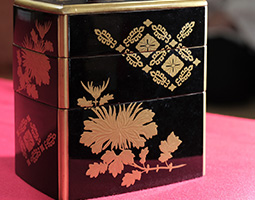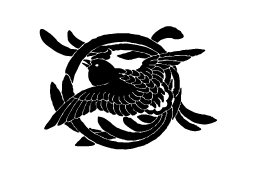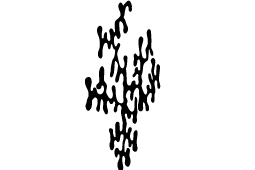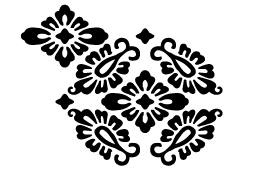December 2022
- English
- 日本語
Yusoku Monyo, the Origin of Japanese Patterns

An obi belt for a modern kimono, decorated with yusoku monyo patterns including “onagadori no maru” (long-tail bird roundels) 
Junihitoe, formal court dress for women. The diamond-shaped pattern on the back is kuchikigata. All of the fabrics including the furnishings are decorated with yusoku patterns

A container for sweets used in the court decorated with a yusoku monyo pattern called “koaoi” (top) 
Onagadori no maru 
Kuchikigata 
Koaoi

We look at yusoku monyo, traditional patterns used first by the aristocracy in the Heian period (late 8th to end 12th century) when dynastic culture flourished in Japan.

Among the many patterns in Japan, yusoku monyo are particularly graceful and elegant, having been used mostly by court nobles* for their clothing, household items and furniture, and architectural designs. These patterns form the basis for the various patterns that developed in Japan. The term “yusoku” refers to knowledge and rules related to ceremonies and events held by the imperial court and the aristocracy, and the patterns were used in a variety of ways according to these rules: in formal clothing for court nobles such as sokutai** for men and junihitoe*** for women; in furniture and personal items, such as desks, cabinets and inkstone boxes; in vehicles such as palanquins and oxcarts; and in architectural decorations.
Many of the motifs for these patterns were natural scenery, animals and plants, and running patterns or fixed patterns contained within a circular or square shape are characteristic of yusoku monyo. Some typical examples include tatewaku, a pattern of continuous curves like boiling steam with clouds, cherry blossoms, or plum blossoms; koaoi, which features a motif considered to be fuyu-aoi (lit. winter hollyhock), and fusecho no maru, which depicts flowers and butterflies within a circle. As running patterns repeat over and over, they were seen as auspicious, and running patterns of the water chestnut (Trapa japonica), an aquatic plant that grows and multiplies particularly well, were often used on undergarments as a prayer for prosperity of descendants.


Yusoku monyo can trace their roots directly to Sasanian Imperial Persia, from where patterns are said to have been brought to Japan via the Asia continent. The tatewaku pattern mentioned above is said to have been derived from the even more ancient Egyptian or Greek palmette pattern****. Hachijo Tadamoto is president of the Kiyou Court Dress Research Institute, who is involved in research and outreach related to traditional dress, and is knowledgeable about yusoku monyo.
“Yusoku monyo are considered distinctive Japanese designs, but if you look closely, you will see that they have an exotic form, which is interesting. The traditional patterns used all around the world today often have their roots in the ancient Orient. The world is interrelated through patterns.”
According to Hachijo, yusoku monyo were changed in a uniquely Japanese way as patterns from the continent were incorporated and repeatedly altered to become distinctively Japanese. During this process, motifs that did not match Japanese sensibilities gradually disappeared.


“Patterns of four-legged animals favored on the continent have mostly disappeared. However, Japanese people of the past must have longed to fly, as they liked birds and butterflies, and their frequent use in pairs is one characteristic of Japanese patterns.”
Just as in this example, Japan’s distinctive yusoku monyo were gradually established. There are other unique Japanese design methods, such as using running patterns as a base and layering fixed patterns on top, called “futae-ori” or partially cutting out and using running patterns called “yare,” and combining two fixed patterns to create a casual impression called “hiyokumon.” Moreover, kuchikigata, a pattern made from the wood grain that rises to the surface of dead, rotted trees, is known as a yusoku monyo pattern that developed within Japan. This pattern, having found beauty in a dead tree, symbolically expresses the sensibilities of the Japanese people who treasure nature.
Having been passed down for more than 1,000 years, yusoku monyo have also given rise to other Japanese patterns. These other patterns include family crests (see here) and komon, a design from the Edo period (early 17th to mid-late 19th century) in which a fine pattern appears across the entire fabric. Yusoku monyo are still typically used for formal clothing today, including for obi belts for kimono. Patterns with roots in the ancient Orient and in ancient Egypt and ancient Greece came to Japan, became uniquely Japanese designs, and are still around today. This in and of itself may speak of the great value of yusoku monyo.

- * Aristocratic government officials who served the imperial court
- ** The sokutai is one of the highest levels of formal attire for men at the court. See Highlighting Japan March 2022 https://www.gov-online.go.jp/eng/publicity/book/hlj/html/202203/202203_02_en.html
- *** Formal attire for ladies in court, worn in layers of various colors. Junihitoe is the popular name for this attire, while it is officially called itsutsuginu-karaginu-mo. See Highlighting Japan October 2020 https://www.gov-online.go.jp/eng/publicity/book/hlj/html/202010/202010_06_en.html
- **** Decorative pattern, with long, thin leaves spreading out like a fan, originally from the ancient Orient

